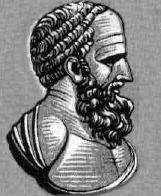

Little is known of Hipparchus's life, but he is known to have been born in Nicaea in Bithynia. Only one work by Hipparchus has survived, and this is certainly not one of his major works. Most of the information which we have about the work of Hipparchus comes from Ptolemy.
Even if he did not invent it, Hipparchus is the first person whose systematic use of trigonometry we have documentary evidence. Hipparchus produced a table of chords, an early example of a trigonometric table. He did this by using the supplementary angle theorem, half angle formulas, and linear interpolation. Hipparchus was not only the founder of trigonometry but also the man who transformed Greek astronomy from a purely theoretical into a practical predictive science. He also introduced the division of a circle into 360 degrees into Greece.
Hipparchus calculated the length of the year to within 6.5 minutes and discovered the precession of the equinoxes. We believe that Hipparchus's star catalogue contained about 850 stars, probably not listed in a systematic coordinate system but using various different ways to designate the position of a star.
The work we have of his, Commentary on Aratus and Eudoxus, was written in 3 books as a commentary on 3 different writings. First, there was a treatise by Eudoxus now lost in which he named and described the constellations. Second, Aratus wrote a poem called which was based on the treatise by Eudoxus and proved to be a work of great popularity. This poem has survived and we have its text. Third, there was commentary on Aratus by Attalus of Rhodes, written shortly before the time of Hipparchus.
The 3 books on which Hipparchus was writing a commentary contained no mathematical astronomy. However towards the end of the second book, continuing through the whole of the third book, Hipparchus gives his own account of the rising and setting of the constellations. Towards the end of the third book, Hipparchus gives a list of bright stars always visible for the purpose of enabling the time at night to be accurately determined. It is thought that this work by Hipparchus was done near the end of his career.
Hipparchus also made a careful study of the motion of the moon. In calculating the distance of the moon, Hipparchus not only made excellent use of both mathematical techniques and observational techniques, but he also gave a range of values within which be calculated that the true distance must lie. He estimated that eclipses have a period of 126007 days. Hipparchus's calculations led him to a value for the distance to the moon of between 59 and 67 earth radii, quite remarkable in that the correct distance is 60 earth radii.
Hipparchus not only gave observational data for the moon which enabled him to compute accurately the various periods, but he developed a theoretical model of the motion of the moon based on epicycles. He showed that his model did not agree totally with observations, but it seems to be Ptolemy who was the first to correct the model to take these discrepancies into account. Hipparchus was also able to give an epicycle model for the motion of the sun, but he did not attempt to give an epicycle model for the motion of the planets.